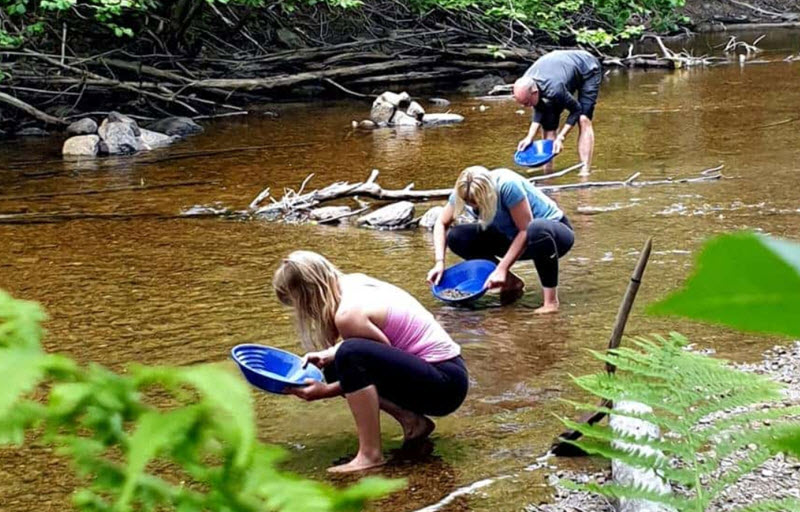Contents
Gold panning is a traditional and labour-intensive extraction method where a pan is used to separate gold from other materials. It is easy to learn and doesn´t require any big investments or complicated infrastructure.
Since it is so labour-intensive, gold panning is only commercially viable if the source material is really rich and labour-costs are really low. Nowadays, gold panning is rarely carried out on a commercial scale. Instead, gold panning is chiefly:
- A hobby (recreational gold panning)
- A tourist attraction, especially in former gold-fields
- A way to prospect interesting areas to see if the findings warrant further investigation.
- To locate the parent gold veins when a placer deposit has been discovered.
When gold panning is offered as a tourist attraction, visitors are typically also provided with a small clear tube to collect any gold dust in as a memento of the experience.
It is possible to find gold nuggets when panning for gold, but it is rare.

How to pan for gold
- Locate a suitable gold deposit.
- Scope sediment into a pan.
- Gently agitate the sediments in water.
- The gold is comparatively heavy and will sink to the bottom of the pan, together with other similarly heavy objects. Less heavy materials are allowed to spill out of the pan.
- The prospector will inspect the objects that have accumulated on the bottom of the pan, and collect any gold or other desirable objects. Exactly what you can expect to find on the bottom of your pan will, of course, vary depending on location, but black magnetite sand is common in many spots.
Different pans
Gold panning has been carried out for thousands of years and in many different parts of the world. Naturally, various types of pans have been developed throughout the years and across the globe.
How large is a gold pan?
Many different sizes are available, but most gold pans are 10-17 inches in diameter. The 14 inch gold pan is especially common.
Angles
Most gold pans have sides that are angled in the 30 degrees – 45 degrees span.
Materials and colours
Gold pans can be created ouf of many different materials, including metal, wood and high-quality plastics.
- Metal pans
In the metal pan cathegory, we find a lot of pans made from heavy gauge steel. During the gold rushes of the 19th century, Russian iron was also common. This was a type of sheet iron manufactured in Russia during the 1800s and early 1900s.
- Plastic pans
Plastic pans are not as heavy as metal pans, but also less strong. An advantage is their resilience to rust. Commercially available plastic pans for gold panning tend to have moulded riffles along one side of the pan. It is a good idea to pick a pan of a colour that makes the heavy materials stand out at the bottom of the pan. Prospectors looking for black sand (a common way of identifying possible gold deposits) sometimes use red pans since the black sand constrat so sharply against the red. Once you know that gold is present in the sediment, you might want to switch your red pan for a black one, since gold contrasts sharply against black.
- Wooden pans
The yuri-ita is a traditional wooden gold pan used in Japan. In Japanese, the name means ”rocking plate” and you pan for gold using a rocking motion. Instead of being round, the yuri-ita is rectangular. It features a concave cross section. One end of the pan is open and the other end is closed.
The batea is a wooden pan used by gold-seekers in areas where water is scarce. Batea is simply the Spanish word för pan or tray, and bateas have traditionally been popular among gold-seekers in arid parts of the Americas, including pars of Mexico. A traditional batea is made from a solid piece of wood and is almost half a meter (20 inches) in diameter.
Features
Examples of features that you may see on gold pans:
- Special help to trap the heavy materials during agitation
- Special help to more easily remove the heavy materials after agitation
- Sharp corners that can be used to break ice
- Accommodations that make the pan extra suitable for use with mercury
- Accommodations that make the pan extra suitable for dry panning
- Screens
